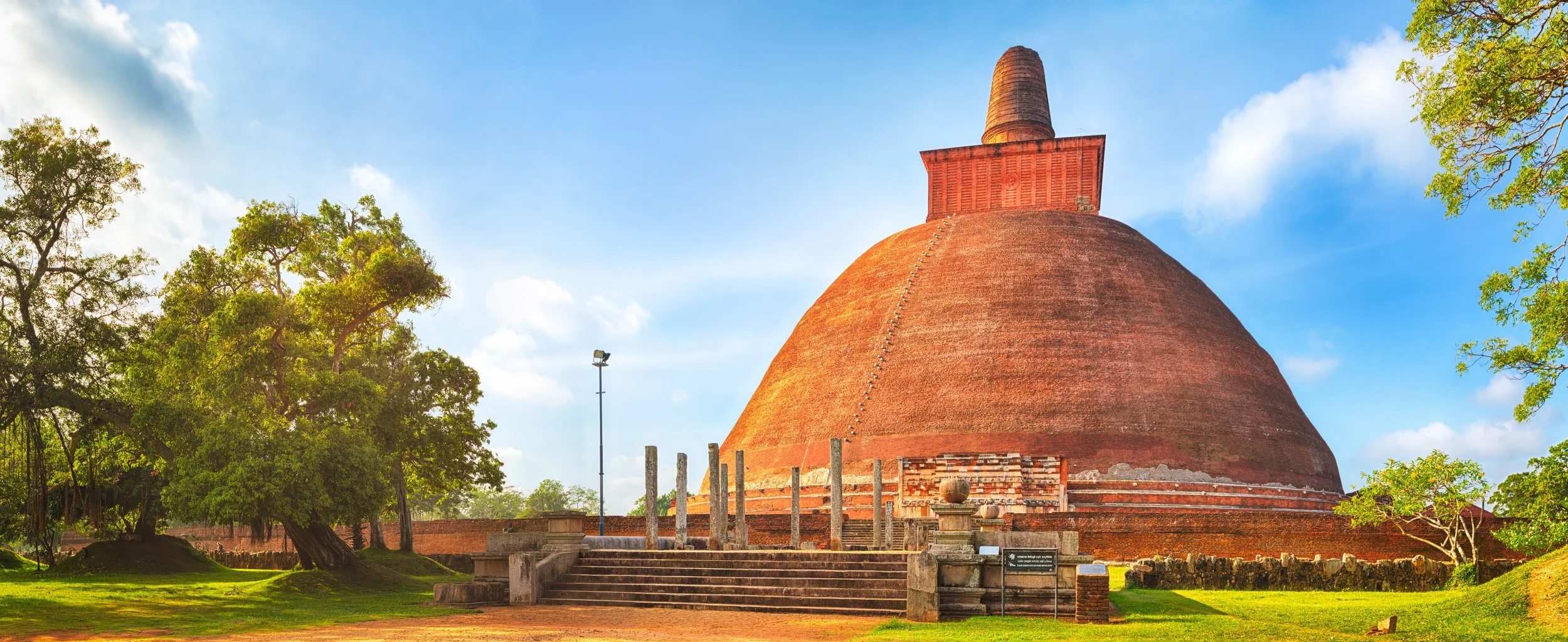AnuradhapurA Part 4: Abhayagiri and Jetavanarama
At a Glance
At these sacred sites in Anuradhapura, one can visit the remains of one of the Buddhist world's most important centers of learning at the Abhayagiri Vihara (A,S), and see the world's largest stupa, Jetavanarama Stupa (A,S).
Abhayagiri Vihara (A, S)
The Story
Abhayagiri Vihara (A, S) was a major monastery site of Theravada, Mahayana, as well as Vajrayana Buddhism that was situated in Anuradhapura. Abhayagiri Vihara refers not only to the complex of monastic buildings, but also to a specific Buddhist lineage which maintained its own historical records, traditions, and way of life. Founded in the 2nd century BCE, it had gained renown as an international institution by the 1st century CE, attracting scholars from all over the world and encompassing all schools of Buddhist philosophy.
Faxian reports that during his time in Sri Lanka, 5000 monks lived at this vihara. He described the hall of the Buddha, adorned with precious substances, gold and silver. At that time, the hall housed a famous jade statue that measured about 30 feet high. Faxian wrote,
“It glitters all over with those substances, and has an appearance of solemn dignity which words cannot express. In the palm of the right hand there is a priceless pearl.”
In the 7th century CE, the famous Chinese pilgrim Xuanzang described the sanghas of Sri Lanka, and referred to the monks of the Mahavihara as the "Hīnayāna Sthaviras" (Pali: Thera), and the monks of the Abhayagiri Vihara as the "Mahāyāna Sthaviras." Xuanzang further writes:
“The Mahāvihāravāsins reject the Mahāyāna and practice the Hīnayāna, while the Abhayagirivihāravāsins study both Hīnayāna and Mahāyāna teachings and propagate the Tripiṭaka.”
Abhayagiri was a major Buddhist university and thus housed a number of important Buddhist scholars working in Sanskrit and Pali. These include Upatissa (who wrote the Vimuttimagga), Kavicakravarti Ananda (who wrote the Saddhammopåyana), Aryadeva, Aryasura, and the tantric masters Jayabhadra, and Candramåli.
In the 8th-10th century CE, both Mahāyāna and the esoteric Vajrayāna form of Buddhism were being practiced at this monastery and two Indian monks responsible for propagating Esoteric Buddhism in China, Vajrabodhi and Amoghavajra, spent time at this monastery. In the Nikāya Saṅgrahaya, a 14th century history of the Theravada lineage, we read that the Vajrayana (referred to as the Vājiriyavāda) arrived from India during the reign of King Matvalasen and that several successive kings were practitioners and supporters of the practitioners based at Abhayagiri.
Jetavanarama Stupa (A, S)
Also within the precincts of sacred Anuradhapura city, the Jetavanarama Stupa (A, S) is the largest stupa in the world. Chronicles state that the Buddha’s belt, or waist sash, was enshrined inside the Jetavanarama Stupa. In addition, the Jetavanarama Stupa marks the location where the arhat Mahinda proclaimed a seven-day Dharma discourse. The compound covers approximately 5.6 hectares and is estimated to have housed 10,000 Buddhist monks.
There were two main Buddhist monasteries established in Anuradhapura, namely the Mahavihara and the Abhayagiri. Since the Mahavihara monastery was the oldest, it received the state patronage to the fullest. Over time, a dispute arose between the monks in these monasteries, and the state patronage switched to the Abhayagiri monastery. Unfortunately, during this period, the the Mahavihara monks were banished, and monastery premises destroyed. Most of their books and records were damaged. This tragedy happened during the reign of King Mahasena because he was misled by Abhayagiri monk, Sangamitta Thero.
While this tragedy was continuing, one of the King’s ministers and friend, Meghavannabhaya, rebeled against this misjustice. Minister Meghavannabhaya raised an army to fight with the King. However, without a war, Meghavannabhaya was able to discuss with the King and restore the good faith in Mahavihara monastery. King Mahasena realized his mistake and tried to restore the Mahavihara monastery to its former glory.
As a result, King Mahasena initiated the construction of the Jetavana Stupa on Mahavihara premises. As the largest stupa in the world, it took approximately twenty-seven years to complete. King Mahasena passed away before the stupa was completed. But his son King Sirimeghavanna continued the effort and completed the stupa.
There are also other theories as to the location of the stupa. Some sources note that this stupa aligns with the three stars in the constellation of Orion, namely Rigel, Al Nitak and Bellatrix, together with Mirisawatiya Stupa and Ruwanweli Stupa.
Coordinates: 8° 22′ 15.4″ N, 80° 23′ 42.9″ E

